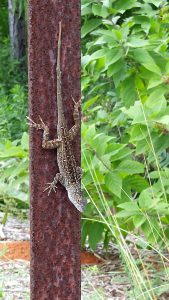The topic of invasive species has been with Floridians for decades. Stories of large pythons, exotic lizards, and crazy ants have been coming out of south Florida for years. Brazilian Pepper, Australian Pine, and Melaleuca are just three species of trees that have invaded the Everglades and other south Florida ecosystems.
Though we are having more problems with plants than animals, north Florida is not without their list of invasive problems. Cogongrass, Chinese Tallow, and Japanese Climbing Fern are well established and resource managers are constantly battling these and other invasives. In recent years Lionfish, Cuban Anoles, and a few sightings of Cuban Treefrogs have made their way onto our radar. All of these invasive species are causing either an environmental problem, an economic one, or both and need to be controlled. However, land and resource managers need to know what is out there to be able to do this; and the public can help.
So what can you do?
One of the most frequently used databases is www.EDDMaps.org. Land and resource managers, both public and private, can view this website to see which species are in the area, where they are located, and how common the species is. However, it is only as good as the data provided. Anyone can report an invasive species on EDDMaps.
From the home page, you can find a variety of information on invasive species. To report a sighting you will need an account. On the toolbar at the top, you will see REPORT SIGHTINGS. Clicking here will take you through a series of questions. There is some information that you need to have ready. For example, how much area of the property does the invasive plant cover? Estimates are fine but try to be as close as possible. You will also need to know your location. Most phones have a compass on them where the Latitude and Longitude are provided. However, it will need to be converted to decimal point to be posted and there is a conversion tool on the website to do this for you. It is important to report your Longitude as a negative number, or else it will think you are in the eastern hemisphere. Photos are very MUCH desired and, again, your phone photo is good enough. On the home page, you will also see how to download the app “I’ve Got One” which is a quick and easy way to report an invasive species while in the field.
If you are not familiar with many of the invasive species, you can spend some time on the website to learn more. You can also contact your local extension office to discuss species that we know are in the area and those that are nearby. These are good species to be on the watch for and, with your help, we can help keep the website updated.
The extension offices in the Pensacola area will be hosting trainings on invasive species identification and EDDMaps reporting later this year. If interested contact Rick O’Connor (850) 475-5230.
- Snake Watch 1st Quarter Report; 2024 - April 20, 2024
- Now is the Time to Search for Invasive Cogongrass - April 20, 2024
- Searching for Mangroves in the Florida Panhandle - April 6, 2024


